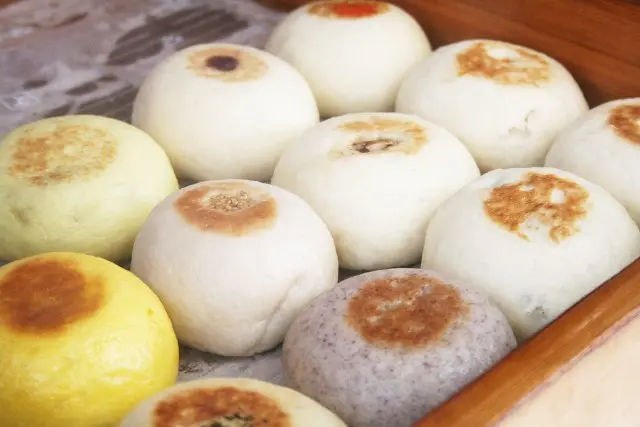6 Types of Wagashi: Delicious Traditional Japanese Sweets

The unique confectioneries of Japan are called "wagashi". These artistic sweets are not only beautiful, but also very delicious, making perfect souvenirs! Let's take a look at the most common varieties.
What Are Wagashi, the Japanese Sweets?

Wagashi are traditional Japanese sweets that have been eaten in Japan for generations. They come in many varieties, from seasonal confections to local sweets that have become iconic for each region in Japan.
Wagashi are highly artistic, with designs that express the beauty of nature and the seasons. Read on to learn about six representative wagashi sweets.
1. Monaka
Monaka is made of glutinous rice flour (*1), mixed with water and stretched into a thin dough, then placed in a mold and baked. The baked dough shell is then filled with red bean jam. The shape of monaka depends on the shop, and while most shops typically make circular monaka, some monaka are molded into interesting shapes like anime characters or local trains.
Originally, monaka only referred to dough shells filled with red bean jam, but in modern times, the word is used even when the dough contains a different kind of filling.
The most famous of these different varieties is “ice cream monaka,” which is filled with vanilla ice cream.
*1... Glutinous rice has high viscosity, and is crushed and kneaded to make mochi (sweet rice cookies).
2. Yatsuhashi
The most famous sweet from Kyoto - yatsuhashi - has a unique texture and a characteristic cinnamon scent.
Yatsuhashi has a tender texture, somewhat like an earlobe, and while most people may picture uncooked yatsuhashi, which are filled with red bean jam, the original version of this sweet used to be baked.
In modern times, the number of flavor variations has increased, and yatsuhashi shaped like animals or anime characters are now sold in stores.
3. Uiro
Uiro is famous as a product of Aichi Prefecture, but in actuality, the recipe was circulating across the country over 130 years ago.
When the Tokaido Shinkansen line opened in 1964, a Nagoya company started selling uiro inside the carriages, which established it in people’s minds as being a Nagoya specialty.
Uiro is made from sticky rice varieties - both nonglutinous and glutinous rice - which are mixed with sugar and hot water, then poured into a mold and steamed. Uiro comes in many flavors, such as green tea and azuki red bean, and can even contain chestnuts. The springy texture and the faintly sweet scent are what gives uiro its popularity, and since it uses glutinous rice, it’s also really filling.
4. Dango

Dango might be Japan’s most beloved sweet treat.
Due to its popularity, it is common for other sphere-shaped objects to be referred to as “dango.” For example, a round nose is a “dango nose,” and a bun hairstyle is a “dango head.”
Dango are made by mixing rice flour or another sort of grain flour with water, then rolling the dough into balls and boiling or steaming them. The recipe is very simple, but there are plenty of flavor variations depending on what the dough is coated with.
The dough can be kneaded with sugar or covered with red bean jam, among other ways. There are also salty dango, which are brushed with soy sauce before grilling.
The most famous variety is mitarashi dango. The appeal of mitarashi dango lies in their salty-sweet flavor, as the dango have been brushed with a thick blend of sugar and soy sauce. In most cases, dango are sold in skewers of three or four, so they’re easy to eat while you walk.
5. Kintsuba
Kintsuba is made of red bean jam which has been solidified with vegetable gelatin, then coated with a mixture of water and wheat flour and lightly fried.
Kintsuba was given its name because of its resemblance to a sword’s hilt guard - called "tsuba" in Japanese.
Compared to other baked wagashi which use red bean jam, kintsuba’s outer shell is very thin. Accordingly, the flavor of the jam really comes through. Some kintsuba varieties use sweet potato or potato in place of bean jam, which makes the kintsuba quite filling.
6. Manju
The last variety we will introduce is manju.
Originally, manju referred to a sweet made of kneaded flour dough, wrapped around bean jam and steamed. Manju is considered to be a variation of the Chinese manto bun.
In modern times, any thick dough confectionery filled with red bean jam may be called a manju or a manto.
Other varieties of manju include mizu manju, which is made of arrowroot flour, and momiji manju from Hiroshima, which is baked after adding eggs and sugar to the dough. Various types of manju exist all over Japan.

Regional specialty wagashi have long histories, and are unique to their locality. If you travel across Japan, seek out the wagashi that have been long-beloved in those areas, and taste them for yourself.
日本への訪日外国人の方が、もっと増えますように!

































![[2026] Family Winter Trip to Suzuka Circuit! – For Both Day trips and Overnight Stays!](https://resources.matcha-jp.com/resize/720x2000/2025/12/26-254097.webp)
![[Northern Okinawa] 4 Recommended Cosmos Fields in Okinawa | Sunflowers and Cherry Blossoms in the Same Season!](https://resources.matcha-jp.com/resize/720x2000/2024/08/12-192028.webp)


